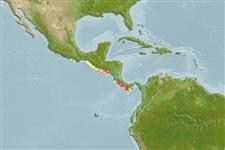>
Anguilliformes (Eels and morays) >
Ophichthidae (Snake eels) > Ophichthinae
Etymology: Ophichthus: Greek, ophis = serpent + Greek, ichthys = fish (Ref. 45335); melope: Name from Greek words meaning black and a hole or cavity, referring to the rings around the pores; noun in apposition.
More on authors: McCosker & Rosenblatt.
Environment: milieu / climate zone / depth range / distribution range
Οικολογία
Θαλασσινό(ά) βενθικό(ς); εύρος βάθους 100 - 224 m (Ref. 31243). Tropical
Eastern Central Pacific: Costa Rica to Colombia.
Μέγεθος / Βάρος / Age
Maturity: Lm ? range ? - ? cm
Max length : 27.0 cm TL αρσενικό/απροσδιόριστο; (Ref. 31243)
Short description
Κλείδες προσδιορισμού | Μορφολογία | Μορφομετρία
Σπόνδυλοι: 146 - 154.
Life cycle and mating behavior
Γεννητική Ωρίμανση | Αναπαραγωγή | Γεννοβολία | Αβγά | Γονιμότητα | Προνύμφες
McCosker, J.E. and R.H. Rosenblatt, 1998. A revision of the Eastern Pacific snake-eel genus Ophichthus (Anguilliformes: Ophichthidae) with the description of six new species. Proc. Calif. Acad. Sci. 50(19):397-432. (Ref. 31243)
IUCN Red List Status (Ref. 130435: Version 2024-1)
Threat to humans
Harmless
Human uses
αλιεία: χωρίς ενδιαφέρον
Εργαλεία
Special reports
Download XML
Διαδικτυακές πηγές
Estimates based on models
Phylogenetic diversity index (Ref.
82804): PD
50 = 0.5000 [Uniqueness, from 0.5 = low to 2.0 = high].
Bayesian length-weight: a=0.00091 (0.00039 - 0.00215), b=2.99 (2.79 - 3.19), in cm total length, based on LWR estimates for this (Sub)family-body shape (Ref.
93245).
Τροφικό Επίπεδο (Ref.
69278): 3.7 ±0.6 se; based on size and trophs of closest relatives
Ελαστικότητα (Ref.
120179): Υψηλό, ελάχιστος χρόνος για διπλασιασμό πληθυσμού < 15 μήνες (Preliminary K or Fecundity.).
Fishing Vulnerability (Ref.
59153): Low vulnerability (17 of 100).
